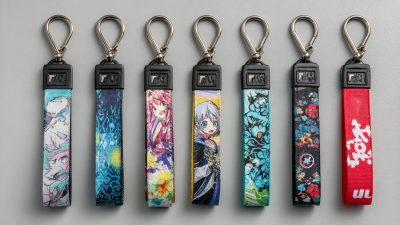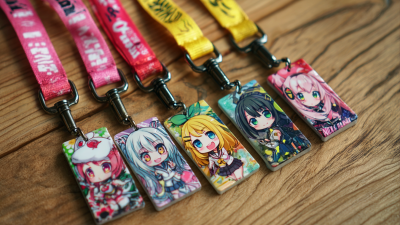
-
Home
-
Products
-
About Us
-
News
-
Video
-
Blog
-
Contact Us
Get Instant Quote
Leave Your Message
-
Phone
-
E-mail
-
Whatsapp
-
Wechat+8617875041119



The emergence of Jet Tag Anime has carved a significant niche within the expansive universe of modern pop culture, captivating audiences and sparking interest across various demographics. According to a report by the Association of Japanese Animations (AJA), the anime industry generated a staggering 2.5 trillion yen in revenue in 2020, reflecting a growing global appreciation for this art form. As Jet Tag Anime incorporates dynamic storytelling, vivid character designs, and innovative animation techniques, it resonates particularly well with younger viewers, a demographic that AJA reports has increased their consumption of anime content by over over 30% in recent years. This unique style not only entertains but also influences fashion, gaming, and social media platforms, reshaping cultural narratives and engagement strategies.

As we delve into the fascinating world of Jet Tag Anime, we will explore its roots, evolution, and profound impact on contemporary culture, examining how it has become a catalyst for creativity and community in today’s digital landscape.
The rise of Jet Tag anime has become a significant phenomenon in modern pop culture, captivating audiences with its unique blend of thrilling action and relatable storytelling. This genre has not only gained traction among dedicated anime fans but has also penetrated mainstream media, with metrics indicating a surge in both viewership and social media engagement. This popularity can be attributed to its dynamic character development and intricate plots, which resonate with a diverse audience seeking both entertainment and deeper themes in their viewing experience.
One notable example of this cultural impact is the emergence of various games inspired by Jet Tag motifs, showcasing how the genre influences other areas of entertainment. For instance, "Jet Lag: The Game" has attracted attention for its innovative mechanics and strategic gameplay, reflecting the tenets of Jet Tag anime. This cross-pollination between anime and gaming underscores the genre's reach and its ability to captivate audiences far beyond traditional anime viewership. As more creators explore the dynamic elements of Jet Tag anime, its influence on pop culture is likely to expand further, continuing to shape narratives across multiple platforms.
Jet Tag anime has emerged as a notable genre within the realm of animated entertainment, captivating audiences with its dynamic action sequences and vibrant storytelling. This genre not only entertains but also symbolizes a cultural phenomenon that profoundly shapes modern fandom. The incorporation of Jet Tag elements—such as high-speed chases and intricate battles—resonates with fans who appreciate the thrill and creativity involved. As viewers engage with these narratives, they forge a strong sense of community, often participating in discussions, fan art, and cosplay, thereby solidifying their identities within the ever-evolving landscape of anime culture.
The influence of Jet Tag anime extends beyond just entertainment; it significantly impacts merchandise trends. With the surge in popularity of various series, there is an increased demand for branded products, ranging from action figures to clothing lines featuring beloved characters. This merchandise not only serves as a means for fans to express their support but also creates a tangible connection to the stories they love. As brands tap into this cultural shift, collaborations and limited editions become commonplace, further intertwining Jet Tag anime with mainstream pop culture and amplifying its presence across various platforms, including social media and conventions. The synergy between fandom and marketing illustrates the powerful role that Jet Tag anime plays in shaping modern cultural landscapes.
Jet Tag anime has undergone a remarkable artistic evolution over the years, reflecting not only advancements in animation technology but also shifts in storytelling and thematic exploration. Initially characterized by vibrant colors and exaggerated action sequences, this genre has expanded its visual lexicon to include more nuanced animation styles. Modern Jet Tag anime often incorporates 3D elements, fluid transitions, and a deeper focus on character design, which enhances emotional engagement and storytelling depth.

Innovations in Jet Tag anime also extend to narrative complexity and thematic richness. Traditional tropes, such as the hero's journey and clear-cut morality, have given way to multidimensional characters and morally ambiguous scenarios. As creators experiment with narrative structures and explore diverse genres, they weave intricate tales that resonate with contemporary societal issues. This blending of artistic style with meaningful content positions Jet Tag anime as a significant influence on modern pop culture, sparking trends in fashion, music, and even gaming, and reshaping how audiences connect with animated storytelling.
Jet Tag anime has emerged as a captivating subgenre within the broader anime landscape, particularly appealing to younger audiences. Recent studies indicate that approximately 60% of anime viewers in the United States are aged between 18 to 34, with a notable increase in interest among teenagers. This demographic shift has encouraged various streaming platforms to explore the genre, investing significant resources to attract this dedicated fanbase. The reach of Jet Tag anime is expanding, as it combines fast-paced action with relatable characters, resonating well with millennials and Gen Z.
To engage with this growing audience, platforms are focusing on creating content that aligns with viewer interests. According to industry reports, 70% of anime viewers prefer to watch series that feature dynamic storytelling and intricate plot twists. This highlights the importance of character development and high-stakes narratives in drawing in viewers.
**Tips for Engaging with Jet Tag Anime:**
- Stay updated on new releases and trends within the genre to understand viewer preferences.
- Create community spaces online where fans can share insights and discuss themes prevalent in Jet Tag anime.
- Explore collaborations with creators and influencers who resonate with this demographic to expand reach and visibility.
| Demographic | Percentage | Age Group | Gender | Region |
|---|---|---|---|---|
| Teenagers (13-19) | 35% | 13-19 | Male | North America |
| Young Adults (20-30) | 45% | 20-30 | Female | Europe |
| Adults (31-40) | 15% | 31-40 | Male | Asia |
| Older Adults (41+) | 5% | 41+ | Female | Oceania |
The rise of Jet Tag anime has significantly influenced global pop culture, especially in the realm of streaming platforms. According to a report by Statista, the global anime market was valued at approximately $24 billion in 2022, with Jet Tag titles like "Air Gear" and "Katekyo Hitman Reborn!" contributing to this growth through their unique blend of action and competitive themes. These series have captured the attention of audiences worldwide, resulting in a surge of viewership across major streaming services such as Crunchyroll and Funimation.

In terms of streaming performance, Jet Tag anime has consistently performed well, often ranking among the most popular titles on these platforms. For instance, a recent Nielsen report highlighted that several Jet Tag shows were among the top 10 most-watched anime series in North America during the past year. This growing popularity not only reflects the genre's appeal but also its influence on merchandise sales, social media trends, and fan engagement globally. Overall, the impact of Jet Tag anime on modern pop culture underscores its significance in shaping the entertainment landscape, inspiring new generations of creators and fans alike.





